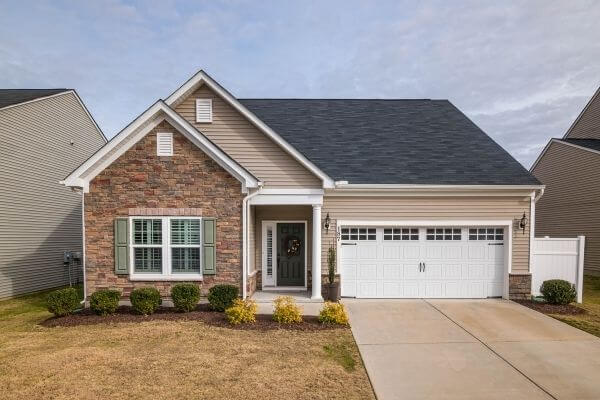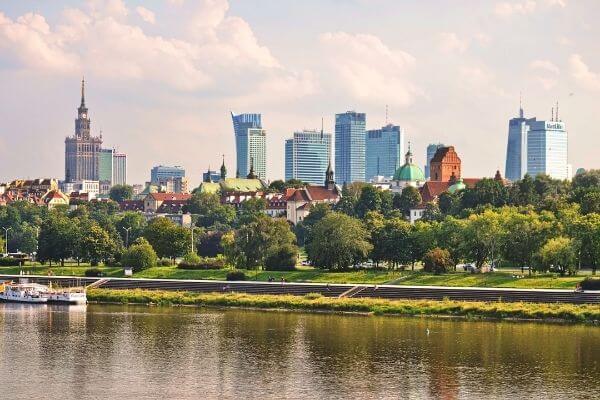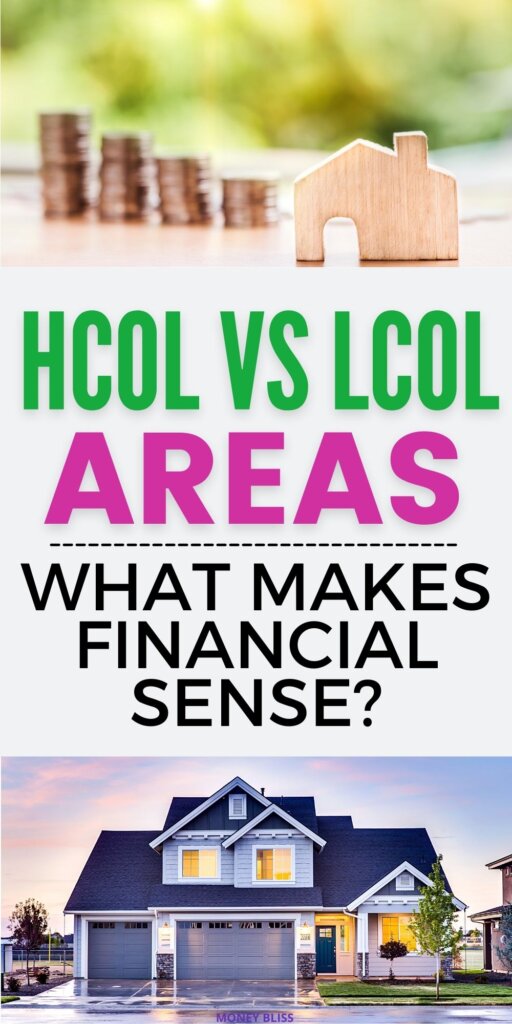HCOL vs LCOL – What Makes Financial Sense?
Inside: The decision on where you live is a big life choice. Learn how an HCOL vs LCOL area will impact you financially. Plus find the cost of living city that fits for you.
HCOL. LOCL. MCOL. What do these acronyms mean and why should I care?
Back when I was trying to decide where to live, there wasn’t a big discussion about the high cost of living or low cost of living areas.
You just picked a city close to family or branched out to a new area. Were you drawn to the big city or not? Plain and simple.
Today, there are many tools at our disposal to try and figure out what is the best city to live in based on income, expenses, and the lifestyle that you desire.
In this post, you will see how to analyze what type of city you want to live in and see if it makes financial sense for you.

Why such the price difference between HCOL and LCOL?
In a low cost of living city, you can buy a house for $50,000. In contrast, a median home price in a high cost of living city can cost $1.5 million. This is a correlation between supply and demand in the market.
The more people who want to live in a certain area that has less available space will naturally drive up prices. Whereas most low cost of living areas, the supply is abundant since there is plenty of space to spread out and find your own neck of the woods for much less.
Here’s a quick comparison of HCOL vs LCOL vs MCOL.
New York City has the highest cost of living at 100, followed by Los Angeles and San Francisco. This graph highlights the difference in cost of living in these example cities.
| HCOL Seattle, WA | MCOL Las Vegas, NV | LCOL Knoxville, TN | |
|---|---|---|---|
| Cost of Living Index | 85.57 | 69.33 | 63.26 |
| 2 Bed Apartment Rent | $2,724 | $1,176 | $788 |
| Median Home Price | $826,200 | $441,771 | $256,188 |
| Median Income | $92,263 | $56,354 | $33,229 |
What is HCOL area Mean?
Simply put, HCOL means a high cost of living.
This type of acronym is to describe certain areas or cities where expenses that impact your budget the most, such as housing, food, and transportation, are more expensive than other areas.
When defining an HCOL area, it is a comparison of the cost of living based on other areas around other cities, states, and countries.
There is no hard line to define high cost of living since it is compared to the other cities.
Is it possible to live in a high cost of living area? Absolutely, it all depends on how you choose to live, the income you make, your lifestyle choices, and your savings percentage.
VHCOL are VERY high cost of living areas, such as Manhattan, Honolulu, San Francisco, Singapore, or Hong Kong.
This post may contain affiliate links, which helps us to continue providing relevant content and we receive a small commission at no cost to you. As an Amazon Associate, I earn from qualifying purchases. Please read the full disclosure here.
Pros and Cons of HCOL

Just because an area is labeled HCOL does not mean that you shouldn’t call the city home and stay away from these areas.
There are plenty of advantages and disadvantages of living in a high cost city.
There are always drawbacks to living in a high cost of living area and you have to decide whether or not what works for you.
In order to make a solid decision on where the best place is for you to live, you need to know this information.
Advantages of HCOL City
- Job Market is Solid
First of all, in HCOL cities, the job market is stronger, there are more jobs available, and typically those jobs have a higher paying threshold than other areas.
That is why many companies are attracted to these areas because they know the talent pool of potential employees is much stronger in high cost of living area versus other areas where there are not as many skilled workers.
- Income is Higher
Since companies know they must pay their employees a fair wage living in a high cost of living area, incomes are higher to support the increased expenses.
This helps those municipalities collect more taxes, which feed back into the system to provide more for their residents.
- More Opportunities
More opportunities abound in a high cost of living cities.
Not only in the job market but there is access to public amenities and conveniences. Some examples include museums, sporting events, transit, best medical services, endless entertainment options, quality restaurants, high-end shopping, and quick access to international airports.
Even better, you can find free entertainment each and every day that does not cost a penny. Here is a list of 101 things to do with no money.
There are many benefits of living in a high cost of living area just because their opportunities are endless. You will always find something to do and there is always stuff going on.
- Better Schools
Typically, in your high cost of living cities, that is where you will find the better schools. This is in direct correlation to the job market and skilled workers.
These skilled workers tend to have a higher instance of college graduates and they tend to want the best for their children. As a result, the schools tend to be much better than you would find in other areas.
- Higher Chance of Home Equity
Another advantage of big cities is the variety of neighborhoods you can find in a bigger city. You can find the type of house you want to live in and the diversity you crave.
While home costs are much higher, there is also a greater chance of income increasing your home equity much faster than other areas.
For example, in Michigan, you could pay $100,000 for the exact same house in 5-10 years since appreciation will not happen at the same rate as other cities. Whereas, if you look at some of the hot markets, like Denver, Phoenix, or Austin, the home prices have been skyrocketing.
Thus, if you live in those quickly appreciating housing areas, there is a higher chance to increase the value of your house.
Disadvantages Of HCOL Cities
- Higher Basic Cost of Living – Specifically Housing
First, housing costs can break the bank. It is the biggest expense for any
household.
If you were unable to secure a salary to justify the housing cost, it makes it nearly impossible to be able to afford to live in a high cost of living area.
This is where you would have to get creative and look for housing subsidies or
other means to stretch your housing budget.
- Harder to Find Houses
Another con of a high cost of living areas is it is much harder to find housing! House and rent prices are higher, jobs are tougher to find where there’s opportunities abound, and you may feel like you are searching for a needle in a haystack.
You need to have the right opportunity to find the proper house for you. If you are looking at buying, you need things to line up properly and in your favor.
- Stretch Yourself Too Far Financially
Since incomes tend to be much higher, many people find the urge to spend more discretionary income.
In many cases, this means that the average household may stretch themselves a little bit further by keeping up with the Joneses. They tend to spend more frivolously and not live as frugal.
This is a trap to be aware of if you are in a high cost of living area. You can be savvy with your money and save, but you have to be cognizant of how you spend your hard-earned salary.

HCOL Cities…
These are the HCOL areas. Do you need to avoid them? No, but going into those areas, you must realize the cost of living will be higher.
Here’s a list of all of the cities that are the top 20 cities that are high cost of living areas according to Kiplinger:
| 1. | Manhattan, New York | (145.7% above U.S. average) |
| 2. | San Francisco, California | (94.7% above U.S. average) |
| 3. | Honolulu, Hawaii | (97.6% above U.S. average) |
| 4. | Brooklyn, New York | (80.5% above U.S. average) |
| 5. | Washington, D.C. | (60.7% above U.S. average) |
| 6. | Seattle, Washington | (56.7% above U.S. average) |
| 7. | Oakland, California | (53.9% above U.S. average) |
| 8. | Arlington, Virginia | (50.5% above U.S. average) |
| 9. | Orange County, California | (50.2% above U.S. average) |
| 10. | Boston, Massachusetts | (48.8% above U.S. average) |
| 11. | Queens, New York | (47.8% above U.S. average) |
| 12. | Los Angeles, California | (46.6% above U.S. average) |
| 13. | Bethesda, Maryland | (45.5% above U.S. average) |
| 14. | San Diego, California | (41.4% above U.S. average) |
| 15. | Alexandria, Virginia | (40.0% above U.S. average) |
| 16. | Stamford, Connecticut | (36.4% above U.S. average) |
| 17. | Portland, Oregon | (34.3% above U.S. average) |
| 18. | Fairbanks, Alaska | (27.9% above U.S. average) |
| 19. | Bergen County & Passaic County, NJ | (26.6% above U.S. average) |
| 20. | Anchorage, Alaska | (24.4% above U.S. average) |
What Is LCOL Area Mean?
LCOL stands for lower cost of living.
These cities have a lower average cost of living versus the average.
Simply put…your ability to stretch your income goes much further in a low cost area compared to a high cost of living area. This is where you can get a bigger bang for your buck.
Pros and Cons of LCOL
The differences in the area where you can live can be vastly different. Thus, providing benefits or drawbacks of choosing to live there.
The cons are typically the reasons that most people want to stay away from these cities.
This is where personal preference tends to play the biggest reason for choosing one location over another.
Just like with a high cost of living area, you need to weigh the pros and cons of
living somewhere where expenses are not quite as high.
Advantages of LCOL –
- Slower Pace of Life
One of the biggest benefits is a slower pace of living in low cost of living area.
Life doesn’t move as fast.
There is more time to breathe, there is more time to step back and take a bigger picture. It is not go, go, go, go 24/7. Time to enjoy the fresh air and slower pace.
- Cheaper Housing
This is why people choose to live in a low cost of living area. Period.
You are able to afford much more house for much less.
That right there, over the long term can make or break somebody financially.
- Lower Taxes
Many of the lower cost of living cities also benefit from lower taxes as well. They have lower income taxes, and even possibly, lower property taxes. So, this is something to take into consideration when looking at a low cost of living area.
Check what the difference would be from where you’re currently at to where you are considering moving.
- Remote Work
This is the bread and butter spot! When you can take in a higher pay and still live in a LCOL city.
After 2020, remote work is becoming more and more popular. In addition, it is an added benefit companies are including to attract skilled employees.
This is one scenario where you can get the best of both worlds.
Disadvantages Of LCOL Cities
- Less Opportunities
First of all, there are fewer opportunities. There are fewer things to do, there are less things going on. The airport is a further drive away.
In a big city, you can always find events happening. It may not be the same in other cities. However, some cities have created programs to draw in residents with the big city feel like Bellefontaine, Ohio.
- Income Potential is Lower
The job market doesn’t have the high-paying jobs that you would find in the bigger cities. The income potential in one of these cities does not compare.
Let’s face it… a good majority of your working years are about built around making an income. With a lower cost of living city, the income limitations can be cumbersome and it takes longer to be able to reach your financial goals.
LCOL States and Countries with LCOL

Geographic arbitrage can give you great value for your money.
Arbitrage is the spread of differing prices for the same thing like rent, food, or transportation.
This means you can save more money by living in LCOL state or spend less of your nest egg by living in a LCOL countries.
These are the areas you can find the lower cost of living. There are many LCOL cities to be found as well.
LCOL States:
| 1. | Mississippi | (84.10% of U.S. average) |
| 2. | Kansas | (86.67% of U.S. average) |
| 3. | Oklahoma | (88.09% of U.S. average) |
| 4. | Alabama | (88.80% of U.S. average) |
| 5. | Arkansas | (89.16% of U.S.average) |
| 6. | Georgia | (89.30% of U.S. average) |
| 7. | Tennessee | (89.49% of U.S. average) |
| 8. | Missouri | (89.75% of U.S. average) |
| 9. | Michigan | (90.54% of U.S. average) |
| 10. | Indiana | (90.57% of U.S. average) |
LCOL Countries:
Listed in alphabetical order because there are many to chose from based on your personal preferences.
- Brazil
- Bulgaria
- Columbia
- Ecuador
- Guatemala
- India
- Indonesia
- Malaysia
- Mexico
- Morocco
- Paraguay
- Peru
- Poland
- Portugal
- Romania
- South Africa
- Thailand
- Turkey
- Ukraine
- Vietnam
Source: https://www.expatistan.com/cost-of-living/country/comparison
What Is MCOL Area Mean?

The definition of MCOL is any area that just has an medium cost of living.
There is not one extreme or another. These cities are just plain average. Maybe slightly above or below the median cost of living.
This can be a sweet spot of reaching your financial goals while enjoying a higher quality of life.
Benefits of MCOL Area
As you can read on Reddit personal finance threads, there are plenty of reasons to live in an MCOL area.
Mostly because these types of cities you can get the best bang for your buck, and still have the pros of living in a high cost of living area, as well as the pros of living in a low cost of living area.
This is where the job market may be very stable with good wages but the cost of living is not going to cost you a fortune.
Also, you can find tons of cities that meet the criteria of a MCOL city.
Cost of Living Varies within Cities

Regardless of whether you choose, HCOL, LCOL, or MCOL areas, the cost of living will be dramatically different between these cities.
Whether you are looking at the downtown area, the outlying suburbs, or maybe even the cities that have popped up around near the main city.
Just because the city is HCOL or LCOL, there will be neighborhoods that will be the outliers to the main part of the city.
So, when you are looking at cost of living, you must know the things that are most important to you and what type of neighborhood that you would want to live in because they can be found.
That is what I call hidden gems.
It is possible to find a cheaper house in a low cost of living or high cost of living area, you just have to do your homework and know what you’re looking for.
Vice versa, it is very possible to find a neighborhood in a low cost of living area that is much higher than the surrounding areas.
How can I buy a house in a high cost of living?

It is possible to be a homeowner in a in a high cost of living area. You just have to be able to afford the down payment on the house to make being a homeowner justifiable, if possible.
Before you decide to buy a house, here are some factors you need to take into consideration..
1. Does it make sense?
First, you have to make sure that it makes logical sense to buy a house. Especially in a high cost of living area because the house prices may not match up to what the income that you are bringing in.
Will you still be able to reach your money goals by purchasing a house? Or will you be house poor?
2. Compare rent to potential mortgage
Will it be cheaper to rent? Or cheaper to have a mortgage?
To figure this out, take what the average rent is in your neighborhood. Then, use a mortgage calculator to figure out the maximum amount you can afford.
Since those calculators will leave you house poor. Decide what you are able to justify in spending on a mortgage and figure out what the mortgage payment is.
Is the mortgage payment less than average rent in the area?
For example, it may cost in a high cost of living area, like San Diego, it may cost $3,000 a month to rent a house. Whereas you might be able to buy a similar home in the same neighborhood and have your mortgage payment of $2,259.
Thus, making buying makes more financial sense than continuing to rent.
3. Expand your horizons
Another tip to afford your dream house – do not be set on that one specific neighborhood in a high cost of living area.
Many times you can find an up-and-coming neighborhood that is much less than the trendier and hip current neighborhoods that you want to live in.
Thus, you can typically save a good chunk of money. Plus in the long run, you greatly increase the potential for home equity.
4. New Homebuyer Programs
If this is the first time you are buying a house, then look into first-time homebuyer programs and grants. (Hint… this is like free money!)
There are many out there because cities want their residents to buy in their neighborhood and their cities because that means they are going to be there for a longer-term.
Also, there are programs for the military, teachers, nurses, single moms, minorities, graduate students. You just have to look.
5. Save for Down Payment
When you are looking at buying a house, this is the time to become serious about saving for a down payment.
You may have to find ways to save more money each month.
This could include things like downsizing your lifestyle to make it possible. Living with friends or family while you save up more money. Or just spending less for a certain period of time until you reach your downpayment goal.
6. House Hacking
The last step is one of the best ways to reach financial independence in a high cost of living city. Plus the concept works well in any city… house hack.
Find a multi-family housing property that you were able to buy. For example, plan to live on one side of the duplex and rent out the other. This will help you pay for your mortgage, by using the rent collected from your renters.
Thus, lowing your overall housing cost, which is your biggest expense.
Where Does Your Income Go the Furthest?

This is a comparison that you may be surprised by the outcome. Thus, proving why you need to do cost comparisons to see what financially makes the most sense when deciding to move from one to the other area.
comparison of income, expenses, taxes, and potential savings!!!!!!!!!!!
Once again, this is personal to your situation. So, take a moment and use the cost of living calculator yourself.
Paying taxes is one option to increase what you take home in each paycheck.
No Income States
These are the states that don’t pay state income taxes on wages:
- Alaska
- Florida
- Nevada
- New Hampshire
- South Dakota
- Tennessee
- Texas
- Washington
- Wyoming
For most people, that is an instant decrease in overall taxes!
Higher Taxed States
Also, if you live in one of the higher taxed states, then you may want to reconsider moving to a lower cost of living area.
The higher taxes income tax states include:
- California
- Hawaii
- New Jersey
- Oregon
- Minnesota
- The District of Columbia
- New York
- Vermont
- Iowa
- Wisconsin
These states tax income somewhere between 7.65% – 13.3%.
Property Taxes
Property taxes vary from state to state.
In some states with large property taxes, it may even out with no income taxes. While other states, like Illinois, where property taxes are high and income taxes are above the national average as well.
Moving From HCOL to LCOL
The reason that most people move from HCOL to LCOL area is to save money. They want to decrease their expenses – that is the primary driver. Other times, it may be that they’re looking for a different type of lifestyle.
But as you can read on Reddit, everybody has a different personal experience.
It may have been beneficial and may have been bad timing. It may have been the best choice. It may have been the worst decision.
Make sure to factor in the costs associated with the move. Also, any ongoing expenses like travel if you are moving away from family.
How to Choose HCOL or LCOL?

Deciding where you live is one of the most personal decisions that you can make. Nobody can make it for you. You know what you want in life, how you want to live, and where you would feel more comfortable.
So, let’s look primarily at the financial side of making this decision of what is best.
1. Lifestyle You Desire
There are massive differences between HCOL and LCOL cities!! In big cities, life moves at a faster pace. While most cheaper cities areas move at a slower pace, so you have to make the decision of what type of lifestyle.
Do you want you want the big city? Do you want suburbia? Or do you prefer more of a country lifestyle?
When looking at this first factor, your answer should not include money. This is where your heart is. This is where your home. This is the life that you plan on living. This doesn’t include the financial sense.
This includes what makes your heart happy.
2. Your Money Goals
One of the things that discussed the most on this site is the 10 Money Bliss Steps to Financial Freedom. That is where most of our readers find their current money goal. And for good reason, you must build a strong foundation with money one step at a time.
In order to achieve long term financial success, the decision on housing is critical as it is the biggest expense in any budget. And that is can have the greatest impact on your budget!
On the flip side, the amount of income you are capable of making can also make the biggest impact on what you can afford to spend.
You must decide on your current money goal as well as the longer term money vision. Maybe you are looking at wanting to retire early? Love to live a slower life in the future?
It is possible to live in HCOL area where you are able to live extremely frugally and save more money. This is what my friend did over at Tuppennys FIREplace. For them, it was a smarter decision. On the flip side, maybe you are happier living a slower pace of life. Income is not the primary driver and you just want to enjoy life more.
At the end of the day, you must prioritize what you want, how your budget and your expenses correlate, and how your saving rate is impacted in various cities.
3. Season of Life
For those in their younger years may not understand this as much, but as you go through seasons of life, you will realize that you have different goals, objectives, and desires along the way.
When deciding where to live, your current season of life will probably have a very high impact on what you are looking for.
If you have young kids, you probably want to find a neighborhood where you have other families nearby that your kids can interact with.
If you are close to retirement, you may look decide to move out of the good school district because you do not need to pay the premium of living here. You may choose to move to a lower cost of living area, so you have the freedom to travel and help my kids and grandkids.
4. Potential Income & Career Opportunities
The greatest benefit of a high cost of living area is the income potential and the career opportunities. Both are much greater in the bigger cities than you would find in the smaller cities.
If your primary goal is increasing your income and advancing your career, then looking at high cost of living areas an absolute must. Plus you might be able to find something on the outskirts of expensive neighborhoods, that would make the most financial sense.
Then, living in HCOL is justified and necessary and the income can justify the higher costs associated.
On the flip side, there is plenty of income potential as a small business owner in a low cost of living area. You just have to know the market, what your skills are in, and what the needs are in your area.
4. Fixed Expenses
Fixed expenses can be dramatically different in each area.
Write out a list of your top fixed expenses and make sure to compare those as well.
For example, child care costs and tuition are going to be much more expensive in a big city than in the suburbs. Maybe in certain neighborhoods, a car would not be needed; thus, eliminating another big cost and associated maintenance.
While some fixed expenses seem meniscal, over time, they can add up significantly. Thus, helping or hurting your financial picture.
Unspoken Price Tag to Live Somewhere

As we covered in this post, there is a lot to consider when deciding between HCOL, LCOL, or MCOL areas.
It is a highly personal decision that you must take the time to make the best decision for you!
Not someone else, but for you.
One thing to watch out for when looking at where to live is what I call the “price tag” of a beautiful city.
Many times, employers know that the city that people want to live in their city for whatever reason. Thus, you will experience what I like to call the “income hit” to living there.
For example, Fort Collins, Boulder, and Austin are highly desirable areas for postgraduates to live in because they fall in love with the town and they want to stay here for the long term. Thus, employers know that this!
As a result, income for jobs maybe 10 to 15% less than they could make in any other type of market or city. So, that is something just to be aware of when wanting to stay in the city that they have grown to love.
In conclusion, when you’re looking at a high cost of living area versus a low cost of living area, there are two sides to the coin.
One – what makes financial sense. Two – your home is where your heart is.
Consequently, you have to make the decision on what makes sense for you.
While it makes financial sense to move to a lower cost city, at the same time, it may move you away from your family and your support system, and everything that you enjoy, and you may not be as happy in the long run.
Enjoy weighing the alternatives between all of the options available.

Did the post resonate with you?
More importantly, did I answer the questions you have about this topic? Let me know in the comments if I can help in some other way!
Your comments are not just welcomed; they’re an integral part of our community. Let’s continue the conversation and explore how these ideas align with your journey towards Money Bliss.

